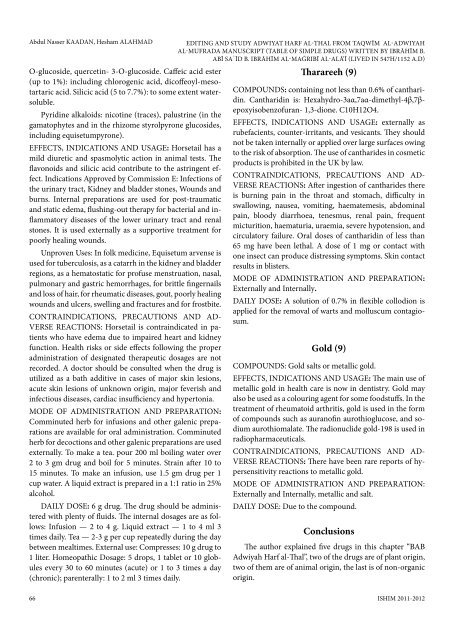Journal of - International Society for the History of Islamic Medicine
Journal of - International Society for the History of Islamic Medicine
Journal of - International Society for the History of Islamic Medicine
Create successful ePaper yourself
Turn your PDF publications into a flip-book with our unique Google optimized e-Paper software.
Abdul Nasser KAADAN, Hesham ALAHMAD<br />
O-glucoside, quercetin- 3-O-glucoside. Caffeic acid ester<br />
(up to 1%): including chlorogenic acid, dic<strong>of</strong>feoyl-mesotartaric<br />
acid. Silicic acid (5 to 7.7%): to some extent watersoluble.<br />
Pyridine alkaloids: nicotine (traces), palustrine (in <strong>the</strong><br />
gamatophytes and in <strong>the</strong> rhizome styrolpyrone glucosides,<br />
including equisetumpyrone).<br />
EFFECTS, INDICATIONS AND USAGE: Horsetail has a<br />
mild diuretic and spasmolytic action in animal tests. The<br />
flavonoids and silicic acid contribute to <strong>the</strong> astringent effect.<br />
Indications Approved by Commission E: Infections <strong>of</strong><br />
<strong>the</strong> urinary tract, Kidney and bladder stones, Wounds and<br />
burns. Internal preparations are used <strong>for</strong> post-traumatic<br />
and static edema, flushing-out <strong>the</strong>rapy <strong>for</strong> bacterial and inflammatory<br />
diseases <strong>of</strong> <strong>the</strong> lower urinary tract and renal<br />
stones. It is used externally as a supportive treatment <strong>for</strong><br />
poorly healing wounds.<br />
Unproven Uses: In folk medicine, Equisetum arvense is<br />
used <strong>for</strong> tuberculosis, as a catarrh in <strong>the</strong> kidney and bladder<br />
regions, as a hematostatic <strong>for</strong> pr<strong>of</strong>use menstruation, nasal,<br />
pulmonary and gastric hemorrhages, <strong>for</strong> brittle fingernails<br />
and loss <strong>of</strong> hair, <strong>for</strong> rheumatic diseases, gout, poorly healing<br />
wounds and ulcers, swelling and fractures and <strong>for</strong> frostbite.<br />
CONTRAINDICATIONS, PRECAUTIONS AND AD-<br />
VERSE REACTIONS: Horsetail is contraindicated in patients<br />
who have edema due to impaired heart and kidney<br />
function. Health risks or side effects following <strong>the</strong> proper<br />
administration <strong>of</strong> designated <strong>the</strong>rapeutic dosages are not<br />
recorded. A doctor should be consulted when <strong>the</strong> drug is<br />
utilized as a bath additive in cases <strong>of</strong> major skin lesions,<br />
acute skin lesions <strong>of</strong> unknown origin, major feverish and<br />
infectious diseases, cardiac insufficiency and hypertonia.<br />
MODE OF ADMINISTRATION AND PREPARATION:<br />
Comminuted herb <strong>for</strong> infusions and o<strong>the</strong>r galenic preparations<br />
are available <strong>for</strong> oral administration. Comminuted<br />
herb <strong>for</strong> decoctions and o<strong>the</strong>r galenic preparations are used<br />
externally. To make a tea. pour 200 ml boiling water over<br />
2 to 3 gm drug and boil <strong>for</strong> 5 minutes. Strain after 10 to<br />
15 minutes. To make an infusion, use 1.5 gm drug per 1<br />
cup water. A liquid extract is prepared in a 1:1 ratio in 25%<br />
alcohol.<br />
DAILY DOSE: 6 g drug. The drug should be administered<br />
with plenty <strong>of</strong> fluids. The internal dosages are as follows:<br />
Infusion — 2 to 4 g. Liquid extract — 1 to 4 ml 3<br />
times daily. Tea — 2-3 g per cup repeatedly during <strong>the</strong> day<br />
between mealtimes. External use: Compresses: 10 g drug to<br />
1 liter. Homeopathic Dosage: 5 drops, 1 tablet or 10 globules<br />
every 30 to 60 minutes (acute) or 1 to 3 times a day<br />
(chronic); parenterally: 1 to 2 ml 3 times daily.<br />
Editing and Study Adwiyat Harf al-Thal from Taqwīm al-adwiyah<br />
al-mufrada Manuscript (Table <strong>of</strong> Simple Drugs) Written by Ibrāhīm b.<br />
Abī Sa`īd b. Ibrāhīm al-Maġribī al-Alā’ī (Lived in 547H/1152 A.D)<br />
Tharareeh (9)<br />
COMPOUNDS: containing not less than 0.6% <strong>of</strong> cantharidin.<br />
Cantharidin is: Hexahydro-3aα,7aα-dimethyl-4β,7βepoxyisobenz<strong>of</strong>uran-<br />
1,3-dione. C10H12O4.<br />
EFFECTS, INDICATIONS AND USAGE: externally as<br />
rubefacients, counter-irritants, and vesicants. They should<br />
not be taken internally or applied over large surfaces owing<br />
to <strong>the</strong> risk <strong>of</strong> absorption. The use <strong>of</strong> cantharides in cosmetic<br />
products is prohibited in <strong>the</strong> UK by law.<br />
CONTRAINDICATIONS, PRECAUTIONS AND AD-<br />
VERSE REACTIONS: After ingestion <strong>of</strong> cantharides <strong>the</strong>re<br />
is burning pain in <strong>the</strong> throat and stomach, difficulty in<br />
swallowing, nausea, vomiting, haematemesis, abdominal<br />
pain, bloody diarrhoea, tenesmus, renal pain, frequent<br />
micturition, haematuria, uraemia, severe hypotension, and<br />
circulatory failure. Oral doses <strong>of</strong> cantharidin <strong>of</strong> less than<br />
65 mg have been lethal. A dose <strong>of</strong> 1 mg or contact with<br />
one insect can produce distressing symptoms. Skin contact<br />
results in blisters.<br />
MODE OF ADMINISTRATION AND PREPARATION:<br />
Externally and Internally.<br />
DAILY DOSE: A solution <strong>of</strong> 0.7% in flexible collodion is<br />
applied <strong>for</strong> <strong>the</strong> removal <strong>of</strong> warts and molluscum contagiosum.<br />
Gold (9)<br />
COMPOUNDS: Gold salts or metallic gold.<br />
EFFECTS, INDICATIONS AND USAGE: The main use <strong>of</strong><br />
metallic gold in health care is now in dentistry. Gold may<br />
also be used as a colouring agent <strong>for</strong> some foodstuffs. In <strong>the</strong><br />
treatment <strong>of</strong> rheumatoid arthritis, gold is used in <strong>the</strong> <strong>for</strong>m<br />
<strong>of</strong> compounds such as auran<strong>of</strong>in aurothioglucose, and sodium<br />
aurothiomalate. The radionuclide gold-198 is used in<br />
radiopharmaceuticals.<br />
CONTRAINDICATIONS, PRECAUTIONS AND AD-<br />
VERSE REACTIONS: There have been rare reports <strong>of</strong> hypersensitivity<br />
reactions to metallic gold.<br />
MODE OF ADMINISTRATION AND PREPARATION:<br />
Externally and Internally, metallic and salt.<br />
DAILY DOSE: Due to <strong>the</strong> compound.<br />
Conclusions<br />
The author explained five drugs in this chapter “BAB<br />
Adwiyah Harf al-Thal”, two <strong>of</strong> <strong>the</strong> drugs are <strong>of</strong> plant origin,<br />
two <strong>of</strong> <strong>the</strong>m are <strong>of</strong> animal origin, <strong>the</strong> last is <strong>of</strong> non-organic<br />
origin.<br />
66<br />
ISHIM 2011-2012
















